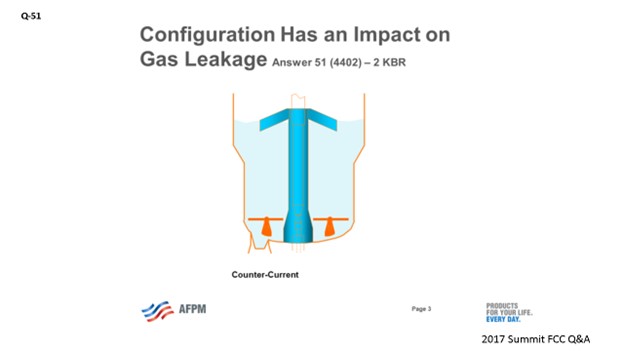Question 51: Can you comment on the safety aspects of placing catalyst in a standpipe to help isolate one vessel from the other? Does the existence of catalyst in a standpipe create a ‘seal’?
TRAGESSER (KBR)
I would like to mention that we will have a P&P tomorrow on this topic, so I will try to keep my answer short. It is assumed that this question relates to using the slide or plug valve to form a seal between the regenerator and the reactor during shutdowns. I would like to point out that this is a standard practice in an FCC as there is really no other option; and for the most part, it does work.
However, unit configuration – specifically what is on the downstream side of the valve – has an impact on how reliable the seal will be. Having catalyst on both sides of the valve is the ultimate scenario to minimize gas leakage from one vessel to the other, even if there is a negative pressure differential.
Shown here is one example of a stacked KBR unit where the spent catalyst plugs valve discharges into a well in the regenerator that always has catalyst in it. In most cases, the well is usually fluidized by steam. For this configuration, even if the pressure differential went negative (meaning, the downstream pressure is higher than the upstream pressure), at most, you would only get a small leakage of steam going backward up the spent catalyst standpipe. As you can see, in this configuration, it would not be possible for air to get into the reactor side of the unit as long as there is a normal catalyst level in the regenerator.

Another example is an older side-by-side unit where the spent catalyst line enters the freeboard side of the regenerator. With this type of configuration, there is more risk for air to leak back into the reactor as there is not a very good catalyst seal on the downstream side of the slide valve.
In all FCC units, the key to minimizing air leakage into the reactor is to ensure that the reactor pressure is above that of the regenerator pressure during periods when oil is out of the unit and there is no catalyst circulation.